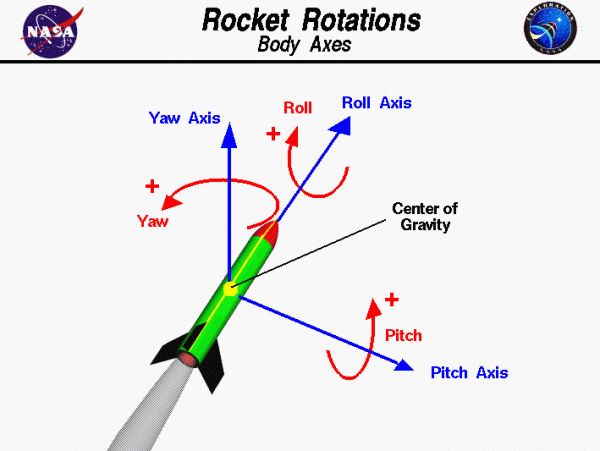Rocket Rotations
Controlling the Attitude
Since we live in a three-dimensional world, it is necessary to control the attitude or orientation of a flying rocket in all three dimensions. In flight, any rocket will rotate about its center of gravity, a point which is the average location of the mass of the rocket. We can define a three-dimensional coordinate system through the center of gravity with each axis of this coordinate system perpendicular to the other two axes. We can then define the orientation, or attitude of the rocket by the amount of rotation of the parts of the rocket along these principal axes.
Axis
Most rockets are symmetric about a line from the tip of the nose to the center of the nozzle exit. We will call this line the roll axis and motion about this axis is called a rolling motion. Because the rocket is symmetric about the roll axis, engineers call this configuration axisymmetric. The center of gravity lies along the roll axis.
To define the other principal axes, we pick some distinguishing characteristic of the design, like a fin placement, or a window location, and place the yaw axis perpendicular to the roll axis and through the center of gravity. On the figure, we have drawn a yellow line on the body of the rocket that lies in the plane formed by the roll and yaw axes. The yellow line passes through the fin on the “top” of the rocket. Motions about the yaw axis are called yaw motions and result in the nose of the rocket moving side to side. The pitch axis is perpendicular to the yaw and roll axes origin at the center of gravity. A pitch motions is an up or down movement of the nose of the rocket.
Maneuvering a Rocket
A rocket can be maneuvered in several different ways. In flight, the fins of the rocket produce aerodynamic forces. These forces are applied at the center of pressure of the rocket which is some distance from the rocket cg and produce torques (or moments) about the principal axes. The torques cause the rocket to rotate. Most full-scale rockets produce pitch or yaw motions by gimballing, or rotating, the exhaust nozzle. If the thrust vector is not aligned with the roll axis, it produces a torque about the center of gravity.

